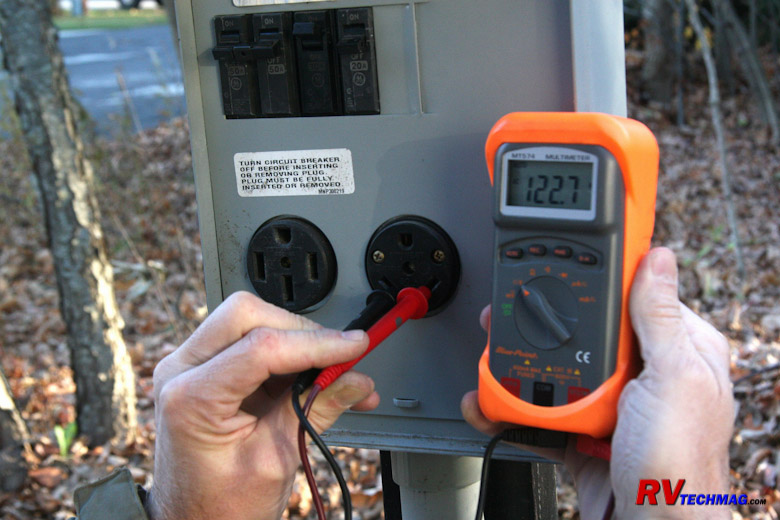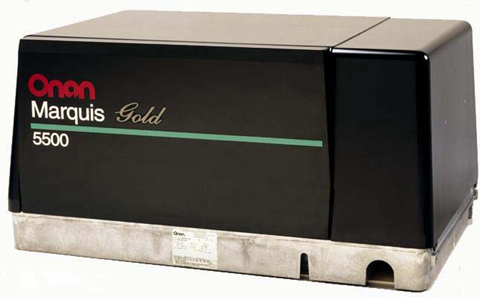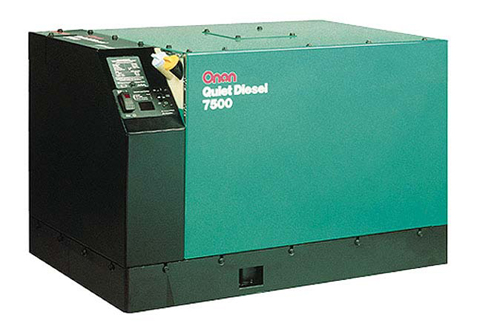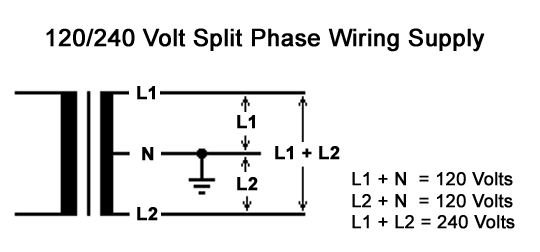|
RV Electrical Tutorial

Chapter 5 - Generators
Motorhomes come with a generator to provide electrical power for those times when shore power isn't available,
such as when driving or boondocking. These units fit into a space that is designed to handle the unique requirements of that
generator, such as cooling air, fuel supply, exhaust piping, and electrical connections. On some units this can be a basement
compartment that is set aside for this use while some motorhomes, most notably diesel pushers, have the generator mounted in
the front cap on a set of extension rails so that it can slide out for service access. These generators are designed for RV
use so they tend to run slower and quieter than the lighter weight portable units found in the construction industry. They can
be powered by gasoline, propane, or diesel fuel and the power output is connected to the automatic transfer switch, as we
discussed in the previous chapter.

Typical Gasoline Powered Generator
Class A motorhomes that have a gasoline powered engine will have a gasoline powered generator. The generator
shares the same fuel tank as the vehicle engine but uses a separate fuel pickup within that tank. These pickups are cut short
so that the generator will not run if the fuel level gets below 1/4 tank. This amount can vary from manufacturer to manufacturer
buy the reason behind it is so that you cannot totally drain your fuel tank while dry camping. The 1/4 tank remainder ensures
that you will always be able to start your RV's engine and drive to a refueling location. These generator sets are designed to
slide into a basement compartment that is designed for that purpose so access to the controls and engine service points is done
through the removable side cover on the generator, which also serves to contain the cooling airflow and add additional sound
deadening capability.

Typical Diesel Powered Generator
Diesel powered generators will be found on a motorhome that is powered by a diesel engine. Some of the entry
level class A diesels are really front engine gasoline chassis with a diesel engine in place of a gasoline engine. In this case
the diesel powered generator will be fairly small, in the 5 KW to 7 KW range, and will be slid into a side compartment in the
same fashion as the gasoline powered generators. On a rear engine diesel pusher the front of the coach is clear of engines
and radiators. In this case you'll find a diesel powered generator that is mounted in the front cap on a set of slide rails.
The generator can be slide forward out of the coach to allow better access for servicing the unit. These units generally
start at around 7,500 watts and run up to 10,000 or 12,500 watts in size. On some older motorhomes a propane powered generator
was used that ran off the RV's on-board LP tank. These are rare though and very undesirable because the limited capacity of the
propane tank didn't give the generator a very long running time before the LP tank was empty. Used coaches with propane powered
generators are very hard to sell and their resale value reflects this.
120 Volts versus 240 Volts:
Motorhomes rarely have any 240 volt appliances so why would it be necessary to have a 240 volt generator? To
answer this let's refer back to our split-phase diagram that we looked at in an earlier chapter.

When you create electrical power there is always a pair of windings in the generator that power is taken from.
Each winding or coil has the potential to create one half of the generator's maximum rated output. On a 6,000 watt generator
each coil will be able to produce 3,000 watts of power. Under normal 120/240 volt portable or large standby generators these
two coils are connected in series, producing 240 volts across L1 and L2. From L1 to the neutral wire or between L2 and the
neutral wire we will have 120 volts. This is no different than the service brought into your home by the electrical utility.
But, these generators are large and they have plenty of power. In the case of an RV our maximum power is limited
to the capacity of our generator. Remember, in the above example we really have two 3,000 watt coils because we need 120 volts.
In order to pull the full 6,000 watts from this generator we either need to run a 240 volt device or else balance out load.
Smaller RV generator sets have found a way around this limitation. By taking the two field coils and arranging them in parallel,
instead of in series, we now have the ability to connect L1 and L2 together and both neutral wires, one from each coil) together
to gives us 120 volts. The downside of this is that we lose the ability to make any 240 volt power but seeing as how our RV
doesn't have anything that requires 240 volts this will work for us. A generator that is wired in this fashion is considered an
in phase generator rather than a split phase generator. These units will be found in both diesel and gas RVs and
will be under 10,000 watts in size. Once you increase the size of the generator to 10,000 watts or more it will be a
split phase generator that produces 120 and 240 volt power. Capacity isn't a problem with the larger generators because
the increased size of each winding provides adequate power to handle the loads. It is important to balance your loads between
the two halves of the breaker panel though and this was discussed back in chapter 3.
Frequency and RPM:
In chapter 1 we saw a graph of the AC and DC waveforms. The vertical height of the waveform represented voltage.
But we also need to control just how fast this electrical pulse occurs. This is plotted horizontally on the graph and is referred
to as frequency, which is labeled as Hertz. In North America all electrical power is 60Hz while in Europe and most
of the rest of the world electrical power runs at 50 Hz. Hz is basically a counter of how many electrical pulses or waves occur
in one second. A small portable generator must run at 3,600 RPM in order to produce 60 Hz electrical power. When you divide 3,600
revolutions per minute (RPM) by 60 seconds we get 60 revolutions per second. It takes two field coils, a north pole and a south
pole, to create the magnetic field necessary to create electricity. There are two field coils in a small portable generator so it
takes one revolution of the generator to create one Hertz. When the generator is turning at 3,600 RPM it will produce 60 Hz. It
doesn't matter what size output the generator makes but the speed at which it turns is important.
Small portable generators tend to be noisy because an engine running at 3,600 RPM isn't very quiet. But they are
light and portable. In an RV application this isn't important because the generator doesn't need to be lifted because it will be
mounted into the RV. What is important is the noise level. If we add a second set of field coils to our generator we will double
the frequency to 120 Hz when running at 3,600 RPM. This isn't good and will burn up our electrical devices. But if we take that
same 4 pole generator and slow it down to 1,800 RPM we will still have 60 Hz. It's just that we are passing twice as many magnets
during the same revolution so by reducing the number of revolutions by half we will still maintain 60 Hz. This is the way many RV
generators are set up. The 1,800 RPM speed of the engine allows for quieter operation. Because we don't have to lift this generator
we can also add a nice large muffler to it. The big drawback is that we have to use a larger engine. A small 8 HP engine is capable
of creating 3,500 watts at 3,600 RPM but when you slow it down to 1,800 RPM it will only put out around 5 HP, which isn't enough.
By going with a 12-14 HP engine we will still have 8 HP available at 1,800 RPM so now we can make our 3,500 watts of power. This
means that the engine will be physically larger, weigh more, and cost more than a smaller engine that is running higher revs. But
the gains are well worth it in an RV application. Large power plants carry this even further and can use as many as 24 field coils
in their generation systems so that they only have to turn 300 RPM. Less RPMs means greater life but more weight and size while
less magnets means less weight and size but greater speed and wear.
We'll cover inverters later on in a future chapter but let's touch on them briefly for a moment. An inverter creates
electrical power electronically. It takes DC battery power and runs it through some electronic processing steps to output higher
voltage AC power. This process is called inversion, which is why the devices are called inverters. In this case there is no
moving parts or magnets so it can electronically control the frequency at which power is output. Onan's Quiet Power series
of diesel generators is a unique hybrid design that uses inverter technology. The generator itself produces DC power instead of AC
power therefore there is no need to control the engine's speed. The faster it turns, the more output it has. The DC power is fed
through an integral inverter that is built into the generator housing to ensure that all AC output is 60 Hz. The advantage to this
method is that the engine RPM can vary as needed. At light loads the engine can run at a very low RPM while at full load the RPM is
increased to its maximum. This has the advantage of less noise and fuel consumption at lighter loads. However, it also has the
disadvantage of being louder at full RPM so if you are running the generator at full load your better off with a fixed 1,800 RPM
generator. The 7,500 and 8,500 watt Quiet Diesel generators use this inverter technology while the larger 10,000 watt and 12,500 watt
units are fixed 1,800 RPM units. The smaller gasoline powered units also do not use inverter technology.
Effects of Altitude:
Any engine will produce a given amount of power based upon how much fuel and air it consumes. High power loads and RPMs
consume more fuel. Because fuel and air are in a somewhat constant ratio, the engine will require more air at higher power outputs.
Unfortunately, as we drive our motorhomes up into higher elevations, the air gets thinner and the engine loses
its ability to produce
its maximum rated power. This results in a corresponding drop in generator output wattage.
Different engines will react in varying amounts. For instance, the output wattage of the Onan Marquis Gold series of
gasoline powered generators will lose 3.5% for every 1,000' in altitude gain over 3,000'. The Onan QuietPower Diesel 10,000 watt will
derate 3.5% for every 1,000' over 500' and it further derates by 1% for every 10° F increase in temperature over 85° F. A good rule
of thumb for most gensets is that you will lose 10% of the rated output every time you gain 3,000' in altitude. This means that a
7,500 watt generator running at 9,000' of altitude will only be capable of producing a bit over 5,000 watts at that altitude.
Diesel engines are pretty well able to handle the fuel injection requirements at higher altitudes but carbureted
gasoline powered engines do not have that luxury. The Onan Marquis Gold series of generators uses carburetors. These gensets do have
an altitude compensation adjustment on the carburetor. By dialing in a higher altitude you will lean out the mixture to prevent spark
plug fouling and excessive smoke. It is very important that you also dial it back when descending to lower altitudes or else the engine
will run lean and you will burn the engine's valves.
In the next section we'll talk about breaker panels and the various output circuits.
Index
|



